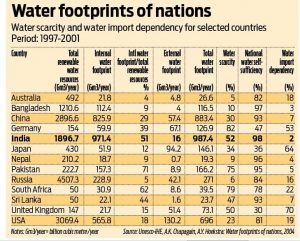https://www.dnaindia.com/business/report-policy-watch-india-splurges-51-of-water-it-could-have-otherwise-saved-1995733
India splurges over half the water it gets
Monday, 16 June 2014 – 6:26am IST | Agency: DNA | R N Bhaskar
If the next wars would be fought for water, it is time to look at how countries manage their own water resources. Savvy countries augment their water needs by importing goods which otherwise would have necessitated additional water consumption. For instance, a country may choose to import rice, and thereby actually save on 1,670 litre of water for every kg of import. This is where a more serious look at water footprints on a global scale becomes all the more imperative.
 As Arjen Y Hoekstra (who originally promoted this concept) states in his paper titled Virtual Water: Measuring Flows around the World, “International trade of commodities implies flows of virtual water over large distances, where virtual water should be understood as the volume of water required to produce a commodity. Virtual water flows between nations can be estimated from statistics on international product trade and estimates of the virtual water content of products. The global volume of virtual water flows related to the international trade in commodities is 1,625 Gm3/year (GM3 means a billion cubic metres – or a trillion litres — of water).”
As Arjen Y Hoekstra (who originally promoted this concept) states in his paper titled Virtual Water: Measuring Flows around the World, “International trade of commodities implies flows of virtual water over large distances, where virtual water should be understood as the volume of water required to produce a commodity. Virtual water flows between nations can be estimated from statistics on international product trade and estimates of the virtual water content of products. The global volume of virtual water flows related to the international trade in commodities is 1,625 Gm3/year (GM3 means a billion cubic metres – or a trillion litres — of water).”
Currently, the global volume of water used for crop production, including both effective rainfall and irrigation water, is 6,390 Gm3/year. The global water footprint is 7,450 Gm3/year, which is 1,240 cubic metres per capita per year.
Adds Hoekstra, “About 80% of these virtual water flows relate to the trade in agricultural products; while the remainder is related to industrial product trade. An estimated 16% of the global water use is for producing products for exports. With increasing globalisation of trade, global water inter-dependencies and overseas externalities are likely to increase. At the same time, liberalisation of trade creates opportunities to increase global water use efficiency and physical water savings.”
But such a wisdom is yet to dawn on India. To understand that, do take a look at an edited version of the Unesco table alongside. The first set of figures to watch is the sixth column of numbers which talks about the total water footprint. India has the largest water footprint from among the countries surveyed in this table. This is in spite of the fact that India is not the most gifted with natural water resources (the second column). China, Russia and the US have more total renewable water resources than India.
Why should this be so? Consider, then, the third column which talks about the internal water footprint. Now calculate the percentage of internal water footprint to total renewable water resources (the fourth column), and you will discover that while most other countries use the water they have more carefully, India has the third highest consumption of its renewable water resources. In other words, even though the US, China and Russia have larger renewable water resources than India, we end up splurging almost 51% of the water that we are blessed with. This profligacy will cost India dearly. This is already evident from the depleting ground water levels in most of the states. The increasing infertility of Punjab’s soil is another pointer to an emerging crisis.
Gujarat is one state which avoided this. It taught its farmers and industry to be more frugal about using water, and a lot more careful about saving the water that nature provides through rains each year. Other exceptions could be some parts of the mountainous north and north-east where constantly melting snowcaps of mountains have helped replenish water reserves. This extravagant use of water in India defies logic. First, because India should not be extravagant with what it does not have in plenty. Second, because India is not a major meat consuming country like China, the US and Russia. Consider for instance that a hamburger needs an estimated 2,400 litres of water. Therefore, major meat consuming countries would be expected to have larger water footprints. A largely vegetarian India ought to have consumed less.
According to Hoekstra, the four major factors determining the water footprint of a country are: volume of consumption (related to the gross national income); consumption pattern (e.g. high versus low meat consumption); climate (growth conditions); and agricultural practice (water use efficiency). It is the last category which has been India’s Achilles’ heel. It has allowed water to get squandered, and has largely ignored water harvesting.
Unfortunately, the countdown for India has already begun. If it does not mend its ways, it will be witness to more water wars within the country than with its neighbours.




































COMMENTS